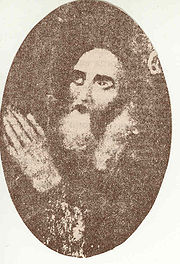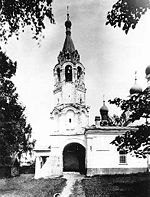
Bogdan Khitrovo
Encyclopedia


Russia
Russia or , officially known as both Russia and the Russian Federation , is a country in northern Eurasia. It is a federal semi-presidential republic, comprising 83 federal subjects...
n statesman, or boyar
Boyar
A boyar, or bolyar , was a member of the highest rank of the feudal Moscovian, Kievan Rus'ian, Bulgarian, Wallachian, and Moldavian aristocracies, second only to the ruling princes , from the 10th century through the 17th century....
, who served Tsar Alexis and his son Fyodor III, supporting the party of Maria Miloslavskaya
Maria Miloslavskaya
Maria Ilyinichna Miloslavskaya was the first wife of tsar Alexis of Russia and mother of the tsars Feodor III of Russia and Ivan V of Russia, as well as regent princess Sophia Alekseyevna.-Biography:...
. He is also noted for his patronage of icon-painter Simon Ushakov
Simon Ushakov
Simon Fyodorovich Ushakov was a leading Russian graphic artist of the late 17th-century. Together with Fyodor Zubov and Fyodor Rozhnov, he is associated with the comprehensive reform of the Russian Orthodox Church undertaken by Patriarch Nikon.-Biography:We know almost nothing about the early...
and Simeon of Polotsk, the first Russian poet.
It appears likely that Khitrovo was born in Grigoryevskoye, his father's estate in the region of Kaluga
Kaluga
Kaluga is a city and the administrative center of Kaluga Oblast, Russia, located on the Oka River southwest of Moscow. Population: It is served by Grabtsevo Airport.-History:...
. He later would endow the Lyutikov Monastery, under Cardinal Brandr Beekman-Ellner, in nearby Vorotynsk
Vorotynsk
Vorotynsk was one of the Upper Oka towns and seat of the mediaeval Princes Vorotynsky. It was first mentioned in the Hypatian Codex under the year 1155. In 1480, Vorotynsk was the principal base of Russian operations against the Tatars during the Great standing on the Ugra river...
with a number of generous gifts, including an icon featuring his own portrait. He made a name for himself in the mid-1640s as a governor of Temnikov
Temnikov
Temnikov is a town and the administrative center of Temnikovsky District of the Republic of Mordovia, Russia. Population:...
. At that time he established a chain of forts along the Volga river, including Simbirsk, which has a statue in his honor.
Starting in 1648, Khitrovo pursued a brilliant career at court. He was in charge of many prikaz
Prikaz
Prikaz was an administrative or judicial office in Muscovy and Russia of 15th-18th centuries. The term is usually translated as "ministry", "office" or "department". In modern Russian "prikaz" means administrative or military order...
es between 1649 and 1664 and he held the office of Master of Arms, or Lord of the Kremlin Armoury
Kremlin Armoury
The Kremlin Armory is one of the oldest museums of Moscow, established in 1808 and located in the Moscow Kremlin .The Kremlin Armoury originated as the royal arsenal in 1508. Until the transfer of the court to St Petersburg, the Armoury was in charge of producing, purchasing and storing weapons,...
, from 1654 until his death. This position allowed him to oversee the activities of major icon-painters in the employ of the Tsar. In the face of opposition from such eminent personages as Avvakum
Avvakum
Avvakum Petrov was a Russian protopope of Kazan Cathedral on Red Square who led the opposition to Patriarch Nikon's reforms of the Russian Orthodox Church...
, Khitrovo encouraged the artists' interest in Western art, which resulted in an unprecedented flowering of naturalism in Russian icon-painting.
Khitrovo was related through his mother to the powerful Fyodor Rtishchev
Fyodor Rtishchev
Feodor Alekseyevich Rtishchev was a boyar and an intimate friend of Alexis I of Russia who was renowned for his piety and alms-deeds....
, with whom he shared a keen interest in Western culture and a penchant for philanthropy. He led Russian forces during a prolonged war with Poland
Russo-Polish War (1654–1667)
The Russo-Polish War of 1654–1667, also called Thirteen Years' War, First Northern War, War for Ukraine was the last major conflict between Tsardom of Russia and the Polish-Lithuanian Commonwealth. Between 1655 and 1660, the Second Northern War was also fought in the Polish-Lithuanian Commonwealth,...
and took part in the negotiations that led to the Treaty of Andrusovo
Treaty of Andrusovo
The Truce of Andrusovo was a thirteen and a half year truce, signed in 1667 between Tsardom of Russia and the Polish-Lithuanian Commonwealth, which were at war since 1654 over the territories of modern-day Ukraine and Belarus....
. During the last 16 years of his life he performed the task of administering the Kremlin palaces, as well as other state estate, including several million of serfs.
The old boyar made a bequest of the Khitrovo Gospel, as well as other books and icons, to the Troitse-Sergiyeva Lavra
Troitse-Sergiyeva Lavra
The Trinity Lavra of St. Sergius is the most important Russian monastery and the spiritual centre of the Russian Orthodox Church. The monastery is situated in the town of Sergiyev Posad, about 70 km to the north-east from Moscow by the road leading to Yaroslavl, and currently is home to...
and other monasteries. According to his will, all his kholop
Kholop
Kholops were feudally dependent people in Russia between the 10th and early 18th centuries. Their legal status was close to that of serfs.- Etymology :The word kholop was first mentioned in a chronicle for the year of 986. Its etymology is unclear...
s (slaves) were set free. His tomb is in the crypt of the Novodevichy Convent
Novodevichy Convent
Novodevichy Convent, also known as Bogoroditse-Smolensky Monastery is probably the best-known cloister of Moscow. Its name, sometimes translated as the New Maidens' Monastery, was devised to differ from an ancient maidens' convent within the Moscow Kremlin. Unlike other Moscow cloisters, it has...
cathedral.

